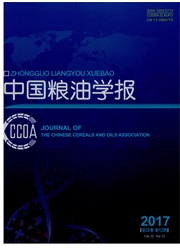

 中文摘要:
中文摘要:
我国是稻米主产国,居民以米饭为主食者人数众多。随着人们对米饭食味品质的要求提高,米饭风味物质组成及含量变化的研究受到关注。在前期研究中,采用固相微萃取(SPME)与同时蒸馏提取(SDE)2种方法,确定了米饭风味物质组成中的lO种关键化合物。为探究稻米加工与米饭风味之间的关系,通过固相微萃取-气相色谱-质谱联用(SPME-GC-MS)技术分别对不同品种、加工程度和破碎度的大米,以及不同蒸煮时间的米饭进行挥发性成分分析。结果显示,粳稻和籼稻的米饭风味物质组成存在明显差别,主成分分析可以明确区分粳稻和籼稻。稻米加工程度提高,米饭风味物质损失严重;相对于糙米,碾磨3、6、9min大米的米饭风味物质含量分别减少了50.7%、73%、79%。随米粒破碎程度提高,米饭风味物质含量呈先增加后减小的变化趋势,在米粒1/2破碎度时风味物质含量最高。米饭中风味物质随蒸煮时间延长,含量和种类增多;醇、酯中的低沸点物质总量降低。试验为今后稻米加工及方便米饭的生产,提供了风味化学方面的理论参考和实践借鉴。
 英文摘要:
英文摘要:
China is a major rice producing country in which rice serves as the staple food for most residents. A- long with the increasing requirement of taste quality of cooked rice, the research on flavor components and content variation of cooked rice also gets more attention. In our previous study, solid phase mieroextraction ( SPME ) and simultaneous distillation- extraction (SDE) were used to confirm ten key compounds from the flavor components of cooked rice. To explore the relationship between rice processing and the flavor of cooked rice, solid phase microextraction combined with gas chromatography and mass spectrometry ( SPME - GC - MS) were used in this study to analyze the volatile components from different rice varieties, milling degree and fragmentation as well as different cooking time. Our results showed that the flavor components from indica and japonica rice have significant difference. Principal component analysis (PCA) could be adopted to distinguish indica from japonica rice. With the increase of milling degree, great loss of the rice flavor components was found. Compared with brown rice, the content of flavor compounds from rice sample after 3 min, 6 min and 9 min treatment of milling has decreased 50.7% ,73% and 79%, respectively. Along with the increase of fragmentation degree, the total amounts of volatile components in cooked rice increased first and then decreased, reaching a maximum in rice sample with 1/2 fragmentation. The content and types of rice flavor compound increased with the increase of steaming time while the total amount of low boiling point substances, alcohol and esters deceased. The results of this research could provide a theoretical reference in flavor chemistry and practical application for future study of rice processing and the production of instant rice.
 同期刊论文项目
同期刊论文项目
 同项目期刊论文
同项目期刊论文
 期刊信息
期刊信息
